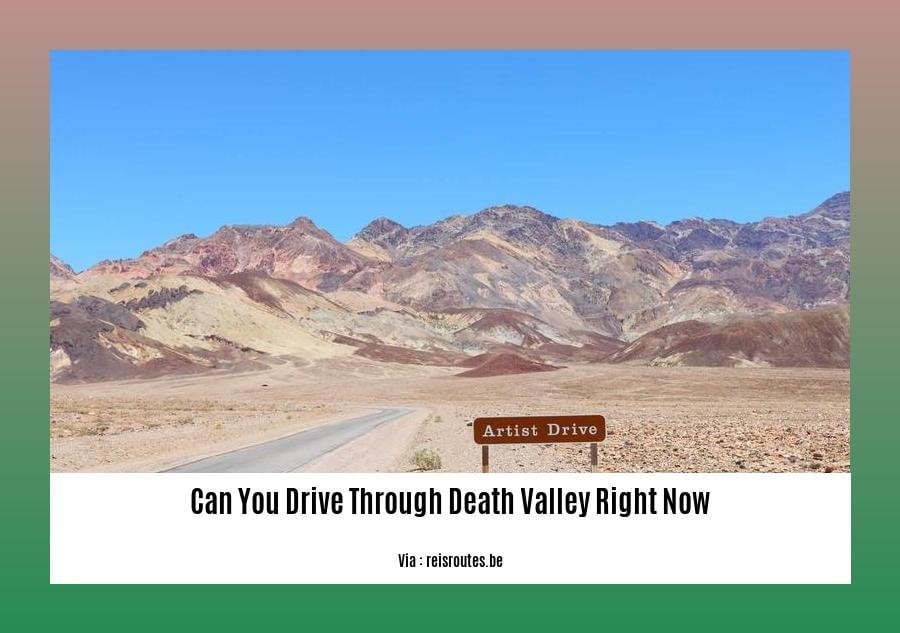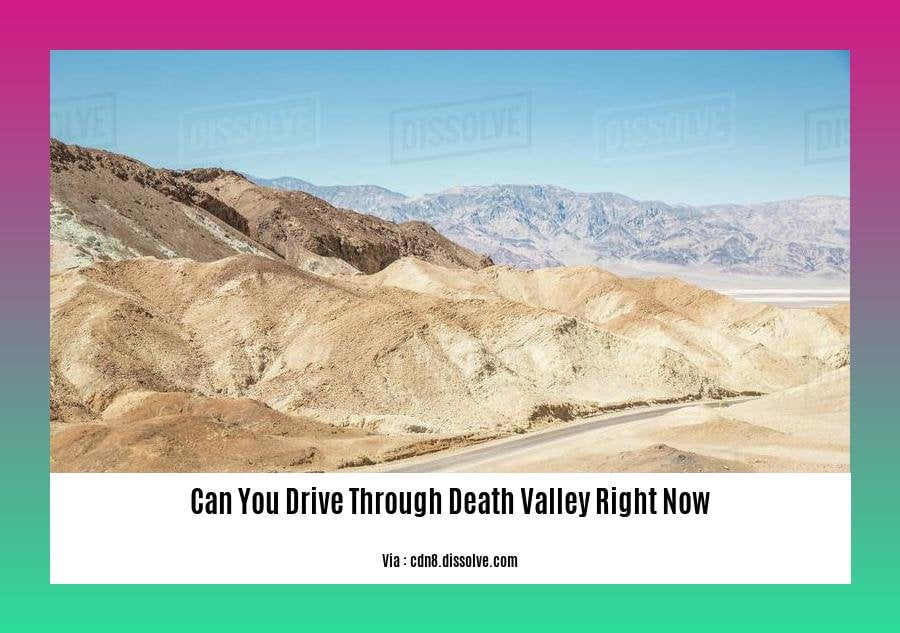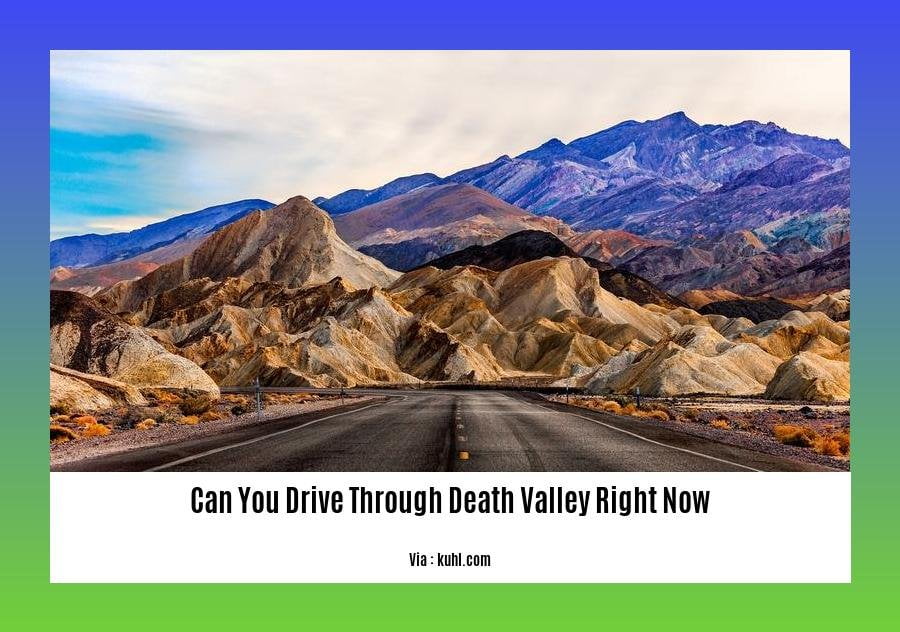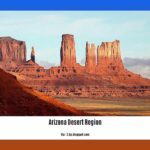Curiosity seekers, adventurers, and road trip enthusiasts are all drawn to the mystique of Death Valley, a captivating landscape filled with untamed beauty and hidden wonders. But before embarking on this iconic desert adventure, it is crucial to assess the current conditions and potential hazards that lie ahead. In this article, titled “Can You Drive Through Death Valley Right Now? Expert Advice on Current Conditions and Hazards,” we will delve into the feasibility of traversing this breathtaking region, providing expert insights and practical tips to ensure a safe and unforgettable journey.
Key Takeaways:
- It is possible to drive through Death Valley, as there are maintained roadways that provide access to various attractions in the area.
- It is important to be prepared and use common sense while driving through Death Valley.
- Travel in an air-conditioned vehicle and stay on paved roads, especially during the summer months.
- If your car breaks down, stay with the vehicle until help arrives.
- Driving off designated roads is prohibited in the park, and backcountry driving on dirt roads requires a vehicle with high clearance, heavy-duty tires, and often 4-wheel drive.
- Illegal marijuana cultivation sites have been found in remote backcountry areas of Death Valley National Park.
- Carry plenty of water and food, share your route with others, and use common sense during your visit.
- Popular sites to explore in Death Valley National Park include Badwater Road, Devils Golf Course, and Artists Drive.
- The best time to visit the park is between November and March when the temperature is more temperate.
Can You Drive Through Death Valley Right Now?

Current Conditions and Hazards
If you’re considering a drive through Death Valley, it’s crucial to have the latest information regarding the feasibility and potential hazards. So, can you drive through Death Valley right now? Let’s delve into the details.
Current Conditions
When it comes to road accessibility, Death Valley has hundreds of miles of well-maintained roads that provide access to various attractions and points of interest within the park. However, it’s important to keep some key factors in mind before embarking on your journey.
First and foremost, weather conditions play a significant role. Death Valley is known for its scorching temperatures, especially during the summer months when the mercury can easily exceed 120°F (49°C). Traveling in an air-conditioned vehicle is highly recommended to ensure your safety and comfort.
Common Sense Precautions
To ensure a safe and enjoyable road trip through Death Valley, it is crucial to abide by certain regulations and recommendations. It is important to stay on paved roads, especially during the summer when extreme heat can cause roads to buckle and become unsafe.
Furthermore, if your vehicle breaks down, stay with your vehicle until help arrives. This is a crucial safety measure and will help rescuers locate you more easily. Remember to carry ample drinking water, as extreme heat and aridity can quickly deplete your body’s hydration levels.
Hazards and Precautions
While Death Valley offers breathtaking vistas and unique experiences, it is crucial to be aware of potential hazards. Driving off designated roads is strictly prohibited, and off-road driving on dirt roads requires a vehicle with high clearance, heavy-duty tires, and often 4-wheel drive.
Additionally, illegal marijuana cultivation sites have been discovered in remote backcountry areas of Death Valley National Park. It is essential to stay vigilant and avoid venturing off the beaten path into unauthorized areas.
Best Time to Visit
To make the most of your journey through Death Valley, it’s best to plan your visit during the months of November to March. During this time, the temperature is more temperate and enjoyable, ranging from the 60s to 80s°F (15-26°C). This allows for a more comfortable driving and exploring experience.
Points of Interest
Death Valley National Park offers a multitude of stunning sights and attractions to explore. Make sure to include the following highlights in your itinerary:
Badwater Road: Experience the lowest point in North America at Badwater Basin, which sits 282 feet below sea level. The vast salt flats and unique geology make this a must-see destination.
Devils Golf Course: Witness the otherworldly landscape of salt crystals and eroded rock formations that resemble a rugged golf course. It’s an awe-inspiring sight you won’t want to miss.
Artists Drive: Take a scenic drive through Artists Drive, where vibrant colors and geological formations mesmerize visitors. Don’t forget to stop and capture the beauty on camera.
Conclusion
To summarize, it is possible to drive through Death Valley, provided you take certain precautions and consider the current conditions. Be prepared for extreme temperatures, stay on paved roads, and remain alert to potential hazards. By following safety guidelines and being mindful of your surroundings, you can embark on a memorable desert adventure through Death Valley.
Remember, the essence of a successful road trip lies in striking a balance between adventure and caution. So, can you drive through Death Valley right now? With the right preparation and a dash of common sense, the answer is yes. Enjoy your journey through one of nature’s most captivating landscapes!
Can you swim in alpine lakes? Find out the answer and dive into the beauty of these pristine lakes by clicking here.
Looking for the perfect spot to take a dip? Discover the wonders of Emerald Cove and learn whether swimming is allowed by clicking here.
Escape to Florida and cool off in its stunning lakes. Check out if swimming is permitted in these refreshing waters by clicking here.
When Will Titus Canyon Reopen?

Key Takeaways:
- Death Valley National Park currently has certain alerts and conditions in place that visitors should be aware of.
- Access to certain areas and trails within the park, including Fall Canyon Trail, Old Stovepipe Wells, Lower Titus Canyon, Ubehebe Crater, and Racetrack Road, is restricted.
- The Wildrose Road / Emigrant Canyon Road is scheduled to reopen sometime after April 2024, following permanent repairs.
- Paved roads in the park, such as CA HWY 190, are open but visitors should expect delays and possible closures for maintenance.
- Unpaved/backcountry roads that are open for travel include Mustard Canyon, Twenty Mule Team Road, and Grotto Canyon.
- Visitors can check road conditions outside the park through Inyo County’s road conditions and the California Department of Transportation (Caltrans) websites.
- Titus Canyon is the most popular backcountry road in Death Valley National Park.
- Titus Canyon Road requires a high-clearance vehicle but does not require 4WD.
- Titus Canyon offers stunning scenic drives, including mountain passes, a ghost town, petroglyphs, and a drive through a canyon.
- Death Valley National Park is gradually reopening certain areas while others may still be closed.
- Visitors should stay updated on the park’s alerts and conditions to plan their trip accordingly.
Death Valley National Park, one of the most iconic desert destinations, is a must-visit for adventurous road trip enthusiasts. However, before embarking on your journey, it is crucial to stay informed about the current conditions and hazards that may affect your experience. In this article, we will explore the feasibility of driving through Death Valley at this specific time, with a focus on the reopening of Titus Canyon.
Death Valley National Park Alerts and Conditions
Currently, Death Valley National Park has issued several alerts and conditions that visitors should be aware of. These alerts provide valuable information regarding access to certain areas and trails within the park. As of now, the following locations are restricted: Fall Canyon Trail, Old Stovepipe Wells, Lower Titus Canyon, Ubehebe Crater, and Racetrack Road. It is important to note that these restrictions may change over time, so it is advisable to stay updated on the park’s alerts.
Reopening of Titus Canyon
One of the most popular backcountry roads in Death Valley National Park is Titus Canyon. Known for its stunning scenic drives, including mountain passes, a ghost town, petroglyphs, and a drive through a magnificent canyon, Titus Canyon attracts many adventurous travelers. However, it is currently closed for public access.
According to the National Park Service, the Wildrose Road / Emigrant Canyon Road, which provides access to Titus Canyon, is scheduled to reopen sometime after April 2024. This reopening comes after permanent repairs are completed to ensure the safety of visitors. While the exact date of reopening is uncertain, it is essential to stay informed about the progress of repairs through reliable sources.
Current Road Conditions and Closures
In the meantime, there are still plenty of paved and unpaved/backcountry roads open for travel within Death Valley National Park. Paved roads, such as CA HWY 190, are generally accessible, but visitors should anticipate potential delays and occasional closures due to ongoing maintenance activities. It is advisable to check for any road closures or delays before your trip to avoid inconvenience.
If you are craving an off-road adventure, there are backcountry roads that remain open for travel. Mustard Canyon, Twenty Mule Team Road, and Grotto Canyon are among the unpaved/backcountry roads where you can experience the rugged beauty of Death Valley. These roads offer unique opportunities to explore the park’s diverse landscape, but it is important to have a high-clearance vehicle.
Staying Informed and Planning Your Trip
To ensure a safe and enjoyable trip in Death Valley National Park, it is crucial to stay updated on the park’s alerts and conditions. You can check the road conditions outside the park through Inyo County’s road conditions and the California Department of Transportation (Caltrans) websites. These sources provide real-time information about potential road closures, weather conditions, and any other relevant updates.
Remember to plan your trip according to the current conditions and restrictions. While Titus Canyon might be closed for now, there are numerous other breathtaking sites and attractions to explore within Death Valley. Take advantage of the open roads, maintain your vehicle properly, and enjoy the wonders this iconic desert destination has to offer.
Sources:
Explore This Site
Key Takeaways:
– Death Valley National Park offers both paved and unpaved roads for exploration.
– CA HWY 190 is open, but visitors should be prepared for delays and various road conditions.
– Driving off designated roads is illegal and harmful to the landscape and ecosystem.
– Visitors should check the park’s official website for current conditions, restrictions, and closures.
– It is recommended to travel in an air-conditioned vehicle and stay on paved roads, especially during the summer months.
– Carry plenty of water and food, share your route with others, and use common sense during your visit.
Are you ready to embark on an adventurous road trip through the magnificent Death Valley National Park? Before you hit the road, it’s essential to understand the current conditions, potential hazards, and practical tips to ensure a safe and memorable journey. Here’s everything you need to know about driving through Death Valley right now.
Road Conditions and Regulations
Driving through Death Valley provides access to awe-inspiring sights and attractions. The park offers both paved and unpaved roads, allowing visitors to explore its unique landscapes. The main paved road, CA HWY 190, is open all the way through the park. However, it’s important to note that delays and multiple road conditions may be present. In addition to paved roads, there are some unpaved/backcountry roads open for travel, such as Mustard Canyon, Twenty Mule Team Road, and Grotto Canyon.
As you plan your journey, it’s crucial to adhere to the park’s regulations. Driving off designated roads is strictly prohibited in Death Valley. This not only helps protect the delicate ecosystem and landscape but also ensures a safe and enjoyable experience for all visitors. Illegal off-roading activities, such as damaging vegetation and disturbing wildlife, have severe consequences. So, remember to stay on paved roads and designated routes as you explore the park.
Current Conditions and Hazards
To ensure a smooth and hassle-free road trip, it’s vital to stay updated on the current conditions, restrictions, and closures. The National Park Service website (nps.gov) provides reliable and real-time information about road conditions and alerts specific to Death Valley National Park. Regularly checking these updates will help you plan your journey accordingly and avoid any unexpected surprises.
While driving through Death Valley, it’s important to be aware of potential hazards. Extreme weather conditions, especially during the summer months, can pose significant risks. The temperatures in Death Valley can soar to extremely high levels, reaching well above 100 degrees Fahrenheit. To stay safe, it is highly recommended to travel in an air-conditioned vehicle and avoid venturing out during the hottest parts of the day. Ensure you have an ample supply of water, as dehydration can be a real threat in this arid desert environment.
Practical Tips for a Safe Journey
To make the most of your Death Valley adventure, here are some practical tips to keep in mind:
- Plan Ahead:
- Research the park’s official website for the most up-to-date information on road conditions, closures, and restrictions.
Check the weather forecast and plan your trip accordingly, avoiding extreme heatwaves.
Stay on Designated Roads:
- Respect the park’s regulations and stay on paved roads and designated routes.
Driving off-road is both illegal and harmful to the environment.
Vehicle Maintenance:
- Ensure your vehicle is in good working condition before setting off.
Check your tires, brakes, and fluids to avoid any preventable breakdowns.
Carry Supplies:
- Pack plenty of water, as dehydration poses a significant risk in Death Valley.
- Bring ample food supplies and snacks for the duration of your trip.
Don’t forget sun protection, including sunscreen, hats, and sunglasses.
Share Your Route:
- Inform family or friends about your planned route and expected return time.
If possible, consider traveling with a companion for added safety.
Be Mindful of Wildlife:
- Death Valley is home to a diverse range of wildlife. Drive cautiously and watch out for animals crossing the road.
- Do not disturb or feed the wildlife, as this can disrupt their natural behaviors.
Remember, exploring Death Valley is an incredible experience, but safety should always be a top priority. By following these expert tips and staying informed about current conditions, you can make the most of your road trip while protecting yourself and the natural beauty of this iconic desert landscape.
Sources:
– National Park Service – Death Valley National Park Conditions
– National Park Service – Safety Guidelines
FAQ
Q1: Can you currently drive through Death Valley National Park?
A1: Yes, it is possible to drive through Death Valley National Park. There are maintained roadways that provide access to various sights and attractions in the area. However, it is important to be prepared and use common sense while driving through the park.
Q2: Are there any restricted areas or trails within Death Valley National Park?
A2: Yes, there are certain areas and trails within the park that are currently restricted. These include Fall Canyon Trail, Old Stovepipe Wells, Lower Titus Canyon, Ubehebe Crater, and Racetrack Road. Visitors should be aware of these restrictions and plan their routes accordingly.
Q3: When will the Wildrose Road / Emigrant Canyon Road reopen in Death Valley National Park?
A3: The Wildrose Road / Emigrant Canyon Road is scheduled to reopen sometime after April 2024, following permanent repairs. Visitors should check for updates on the road’s status before planning their trips.
Q4: What should visitors expect in terms of road conditions and possible closures in Death Valley National Park?
A4: Paved roads in the park, such as CA HWY 190, are open but visitors should expect delays and possible closures for maintenance. It is important to stay updated on the park’s alerts and conditions to plan your trip accordingly.
Q5: What are some of the open unpaved/backcountry roads in Death Valley National Park?
A5: Some of the unpaved/backcountry roads that are open for travel in the park include Mustard Canyon, Twenty Mule Team Road, and Grotto Canyon. These roads offer alternative routes for visitors who are interested in exploring the park’s more remote areas.
- Save Green Pythons Now: Urgent Conservation Strategies - April 24, 2025
- Robert F. Williams: Armed Resistance, Civil Rights Legacy - April 24, 2025
- Open Door Notes: Unequal Trade, Lasting Impact on East Asia - April 24, 2025
















